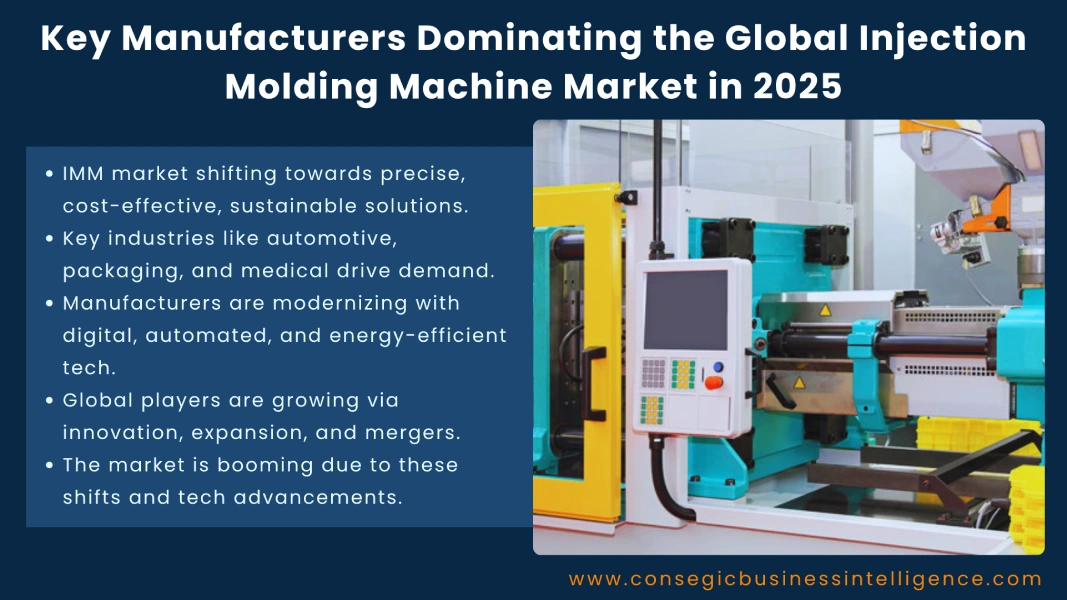Key Manufacturers Dominating the Global Injection Molding Machine Market in 2025
The global injection molding machine (IMM) market is being changed significantly by the growing need for high-precision, low-cost, and sustainable manufacturing solutions in automotive, packaging, consumer goods, electronics, and medical sectors. Manufacturers have been modernizing their production lines with digital controls, automation, and energy efficiency, and the global players are reinforcing their presence by innovation, capacity expansion, and strategic mergers.

We are going to focus on the key manufacturers projected to lead the global injection molding machine market in 2025 and how their activities such as R&D, regional expansion, and product diversification impact the industry.
- Haitian International Holdings Ltd. (China)
Haitian International is the number one producer of IMM in the world in terms of the quantity of machines sold. Their Mars Series combines the servo-hydraulic energy-saving technology that has gone viral worldwide. Haitian’s budget-friendly machines, robust international sales network, and aggressive market penetration strategy in Asia-Pacific, Europe, and Africa make it a dominant player heading into 2025. The company’s initiative towards smart manufacturing and all-electric IMM further strengthens its position in the competition.
- ENGEL Austria GmbH (Austria)
ENGEL is still an example of high precision engineering, hybrid systems, and digital injection molding solutions. They are known as tie-bar-less machines and for Industry 4.0 integration, and ENGEL is the supplier of high-end applications in automotive interiors, packaging, and medical equipment. Their inject 4.0 digital platform and their goal of getting rid of carbon footprint by utilizing energy-efficient systems put them in the leading position for sustainable injection molding in 2025.
- ARBURG GmbH + Co KG (Germany)
One of the leading players in the global IMM market, ARBURG is globally recognized for its ultra-fast, high accuracy electric machines that are designed for intricate components and micro-molding sectors. The ALLROUNDER series offers excellent versatility and has found its place in medical and electronics industries. ARBURG is placing strong emphasis on AI technology-based quality assurance, predictive maintenance, and data analytics for production control systems to be compatible with future industries.
- Sumitomo (SHI) Demag Plastics Machinery GmbH (Germany/Japan)
Sumitomo Demag has taken the initiative to lead all-electric injection molding systems that are aimed at zero-defect production in the medical and high-volume packaging sectors. Their IntElect series are machine types that are designed to have short cycle times, provide high repeatability and save energy. As emission regulations become more stringent in Europe and America, Sumitomo Demag’s technologies of low carbon and noise reduction have positioned them as a primary candidate for 2025 victory.
- Nissei Plastic Industrial Co., Ltd. (Japan)
Nissei produces electric, hybrid, and hydraulic machines in a broad variety that are geared to the sectors of automotive, medical, and electronics. Their TWX-R hybrid vertical machines and FVX-III series are good examples of insert molding. Nissei's decision to set up global production bases, including those of North America and Southeast Asia, further strengthens supply chain response and customer support—key conditions for market leadership.
- Milacron LLC (U.S.)
Milacron, an injection molding parts and services provider with their home base in North America, primarily concentrates on servo-hydraulic and electric injection molding systems. Milacron’s F-Series and Elektron EVO are examples of their product line that targets packaging, automotive, and medical fields. Milacron’s after-sales service commitments, their incorporated automation, and the use of process control software have become new production solutions for lean manufacturing principles.
- KraussMaffei Group (Germany)
KraussMaffei as always is trying to extend the limits of large-tonnage IMMs, which are necessary for the production of heavy-duty automotive and industrial components. The GX series is all about hybrid and electric models with outstanding modularity along with digital control features. The investment of the group in plastics recycling of the circular economy and the integration of machine learning are believed to offer a strategic advantage around 2025.
Market Outlook: Why These Leaders Matter
The global IMM market is expected to exceed USD 15 billion by 2025, with Asia-Pacific leading both production and consumption. Major trends driving this growth are:
- Sustainability and precision through machine electrification.
- Digital twin and AI implementation for process monitoring.
- Increase in medical disposable and EV parts demand.
- Smart factory and Industry 4.0 protocols adoption.
The above-listed manufacturers are adjusting their R&D, product offerings, and regional expansion to take advantage of these opportunities. Their leadership in automation, sustainability, and advanced control systems gives them the prime spot in the changing market landscape.
Frequently Asked Questions:
How big is the injection molding market?
Injection Molding Machine Market Size is estimated to reach over USD 18.38 Billion by 2032 from a value of USD 12.94 Billion in 2024 and is projected to grow by USD 13.30 Billion in 2025, growing at a CAGR of 4.8% from 2025 to 2032.
What is the demand for injection molding?
Demand is increasing due to the growing need for precision parts, mass production capability, and material versatility in sectors like consumer goods and healthcare.
Who is the world’s largest injection molding machine manufacturer?
Haitian International Holdings Ltd. holds the top position globally in terms of unit sales and production capacity.
What is the future of injection molding?
The future lies in all-electric machines, AI-based quality control, sustainable materials, and Industry 4.0-ready platforms.
What is the disadvantage of injection molding machines?
They have high initial costs, limited to high-volume production, and design constraints for thick-walled or complex parts.
What industry uses injection molding?
Industries include automotive, medical, packaging, electronics, construction, and aerospace.
Is injection molding cheaper than 3D printing?
For large production volumes, injection molding is cheaper per unit. However, 3D printing is more economical for prototyping and low-volume runs.
What is the injection molding machine market forecast?
The market is expected to grow at a CAGR of over 4.8% from 2025 to 2032, fueled by automation, demand in emerging economies, and sustainable manufacturing initiatives.
